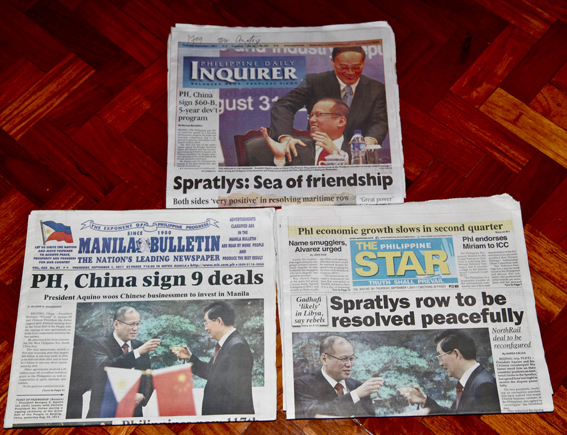- HOME
- INTRO TO THE FORUM
- USE AND MISUSE
- BADLY WRITTEN, BADLY SPOKEN
- GETTING
TO KNOW ENGLISH - PREPARING FOR ENGLISH PROFICIENCY TESTS
- GOING DEEPER INTO ENGLISH
- YOU ASKED ME THIS QUESTION
- EDUCATION AND TEACHING FORUM
- ADVICE AND DISSENT
- MY MEDIA ENGLISH WATCH
- STUDENTS' SOUNDING BOARD
- LANGUAGE HUMOR AT ITS FINEST
- THE LOUNGE
- NOTABLE WORKS BY OUR VERY OWN
- ESSAYS BY JOSE CARILLO
- Long Noun Forms Make Sentences Exasperatingly Difficult To Grasp
- Good Conversationalists Phrase Their Tag Questions With Finesse
- The Pronoun “None” Can Mean Either “Not One” Or “Not Any”
- A Rather Curious State Of Affairs In The Grammar Of “Do”-Questions
- Why I Consistently Use The Serial Comma
- Misuse Of “Lie” And “Lay” Punctures Many Writers’ Command Of English
- ABOUT JOSE CARILLO
- READINGS ABOUT LANGUAGE
- TIME OUT FROM ENGLISH GRAMMAR
- NEWS AND COMMENTARY
- BOOKSHOP
- ARCHIVES
Click here to recommend us!
MY MEDIA ENGLISH WATCH
If you are a new user, click here to
read the Overview to this section
Team up with me in My Media English Watch!
I am inviting Forum members to team up with me in doing My Media English Watch. This way, we can further widen this Forum’s dragnet for bad or questionable English usage in both the print media and broadcast media, thus giving more teeth to our campaign to encourage them to continuously improve their English. All you need to do is pinpoint every serious English misuse you encounter while reading your favorite newspaper or viewing your favorite network or cable TV programs. Just tell me about the English misuse and I will do a grammar critique of it.
Read the guidelines and house rules for joining My Media English Watch!
Doing a mop-up job on media’s remarkably improved grammar
I’m delighted to take note that during the past week, the four major Metro Manila broadsheets and the online news websites of the two major TV networks have been remarkably free of English grammar and usage errors—not of the kind anyway that’s worthwhile dissecting for its instructive value to English learners. Indeed, the incidence of grammatically faulty English in these media outlets has steadily diminished these past several weeks, indicating greater grammar consciousness among their writers as well as more vigilant and tighter editing by their editors. If this very heartening trend continues for another four weeks or so, I guess I’ll just have to leave these media outlets alone and set the sights of my English watch elsewhere—or perhaps discontinue it for good.
In the meantime, let me do a mop-up job on some not-so-serious grammar and usage problems that I spotted in three of the media outlets during the weekend.
(1) Manila Bulletin: Use of pronoun with wrong antecedent nouns twice in a row
Unilab holds contest for the youth
MANILA, Philippines — After spreading the power of positive ideas during its launch last year, Unilab, through its Unilab Ideas Positive program, once again calls on the youth to share their or ideas that can be turned into tangible solutions for community health and wellness.
Unilab Ideas Positive is an idea-generation contest for social marketing programs that address issues in hygiene and sanitation, nutrition, disease prevention and intervention, and environmental care and protection.
The lead sentence above is grammatically faulty and very confusing because it misuses the possessive adjective “its” twice, the first time with a wrong antecedent and the second time with a fuzzy antecedent. The logical subject of the prepositional phrase “after spreading the power of positive ideas during its launch last year” should be the proper noun “Unilab Ideas Positive program,” for it is obviously the entity—not Unilab itself—that was launched last year and that had done the spreading of the power of positive ideas. However, due to its improper positioning, “Unilab” usurps this grammatical role and wrongly becomes not only the subject of that modifying phrase but also the antecedent of the possessive adjective “its” in that modifying phrase. Further compounding the problem is the ill-advised insertion of another prepositional phrase, “through its Unilab Ideas Positive program,” between the main clause and subordinate clause. By this time, the reader can no longer be sure of what the legitimate subject of that sentence is—“Unilab” or the “Unilab Ideas Positive program.”
So how do we untangle that pretzel of a sentence—a construction that I am tempted to say has a strangely squinting subject?
A simple, straightforward fix is to get rid of the noun “Unilab” altogether and let the proper noun “Unilab Ideas Positive Program” do the job alone, as follows:
“After spreading the power of positive ideas during its first year, the Unilab Ideas Positive program once again calls on the youth to share their ideas and turn them into tangible solutions for community health and wellness.”
Of course, it would be unforgivable for such press releases not to mention the program sponsor at all. For that purpose, I suggest rewriting the second paragraph to give appropriate mention to the sponsor along with the nature of the contest and the prizes at stake. I suggest the following treatment for that second paragraph:
“Run by United Laboratories, the Unilab Ideas Positive is an idea-generation contest for social marketing programs that can effectively address issues in hygiene and sanitation, nutrition, disease prevention and intervention, and environmental care and protection. The contest offers a total of P250,000 in seed money to the winning youth teams.”
(2) GMA News Online: Questionable habitual use of the adverb “initially”
DFA: No Pinoy hurt in Egypt protest violence
No Filipino was initially reported hurt in the violence that marred a demonstration at the Israeli embassy in Egypt, the Department of Foreign Affairs said Saturday.
DFA spokesman Raul Hernandez cited initial information from the Philippine Embassy in Egypt indicating Filipinos there are safe so far.
I notice that it has become habitual for some TV news reporters to use the slippery adverb “initially” to describe the outcome of a still ongoing event, as in the clause “No Filipino was initially reported hurt…” in the lead sentence above. It sounds even more macabre when a report says “No Filipino was reported killed…” No matter how I look at this usage, it always seems to me a disingenuous and misleading kind of reporting—one that suspiciously looks like a cover-up for slipshod information-gathering or an advance justification for deniability. In reality, it’s either some people get hurt or die in a violent event or none at all, regardless of whether the report is initial, intermediate, or final. Semantically, therefore, it’s misleading to say “someone was initially reported hurt”; the truthful way to say it is “an initial report said someone was hurt.”
So why can’t TV reporters avoid using “initially” altogether in such instances? They can be more factual and semantically accurate by reporting such developments as follows:
“An initial report said that no Filipino was hurt in the violence that marred a demonstration at the Israeli embassy in Egypt, the Department of Foreign Affairs said Saturday.
“DFA spokesman Raul Hernandez cited information from the Philippine Embassy in Egypt that Filipinos there are safe so far.”
(3) Associated Press: Inappropriate word choice; use of wrong relative pronoun “which”
Mayor Cox Elorde of Bunawan township, Agusan del Sur Province, pretends to measure a huge crocodile which was captured by residents and crocodile farm staff along a creek in Bunawan late Saturday in southern Philippines. Elorde said Monday that dozens of villagers and experts ensnared the 21-foot (6.4-meter) male crocodile along a creek in his township after a three-week hunt. It was one of the largest crocodiles to be captured alive in the Philippines in recent years. (AP Photo)
In the caption above, the phrase “pretends to measure” is a demeaning, unjournalistic value judgment on the act of the good mayor in using his own body to give people a better idea of the size of the giant crocodile. To “pretend” means to “give a false appearance of being, possessing, or performing something,” and I don’t think this characterizes what the mayor is doing in earnest in that picture. Perhaps a more factual and nonjudgmental description is the following:
“Mayor Cox Elorde of Bunawan township, Agusan del Sur Province, sizes up a huge crocodile that was captured by residents and crocodile farm staff along a creek in Bunawan late Saturday in southern Philippines. Elorde said Monday that dozens of villagers and experts ensnared the 21-foot (6.4-meter) male crocodile along a creek in his township after a three-week hunt. It was one of the largest crocodiles to be captured alive in the Philippines in recent years.”
Note that in the rewrite of that caption’s first sentence, I replaced “which” with “that” to reflect the fact that what’s linked by the relative pronoun to the main clause—the subordinate clause “(that) was captured by residents and crocodile farm staff along a creek in Bunawan late Saturday in southern Philippines”—is a restrictive modifying clause, which grammatically requires the restrictive relative pronoun “that” instead of the nonrestrictive “which.”
Click to read responses or post a response
How the photoeditors of three Philippine major newspapers differ
Posted by charlieagatep, Forum member (September 6, 2011):
Yesterday, September 1st, 2011, I was reminded about the Power of Visual Images as I compared the front page main photos of the Manila Bulletin, Philippine Star and Philippine Daily Inquirer. Look at them yourselves, do you see what I see?

The Bulletin and Philippine Star displayed exactly the same photos released by Reuters: President Aquino toasts with Chinese President Hu Jintao during a signing ceremony at the Great Hall of the People in Beijing Wednesday, August 31, 2011. The Star’s photoeditor did a tighter cropping but both photos are identical.
However, the main photo of the Inquirer is totally different. It is the photo of President Aquino smiling as China's Vice Premier Wang Qishan lays his hands on the President’s shoulders “as though ready to massage them” during the Philippine-China Economic Trade Forum held at the China World Hotel in Beijing Wednesday Aug. 31.
One of the things I learned from our photo-journalism instructor at Boston University’s School of Public Relations was this: A good news photograph is one that tells a story without the aid of a caption. To me, the PDI photo is the best of the three pictures. It is clear that PDI photographer Edwin Bacasmas grabbed a human-interest angle, thus seizing the eyes and interest of readers. It shows as if Vice Premier Qishan is saying to President Aquino, “Partner, feel at home ka lang, ha?”
We all appreciate that a photo is often more precise than the printed word in communicating a message. Photos can create curiosity, or pull the reader “to a new view of the familiar.” That is why, unknown to many, a photoeditor’s job is crucial. He decides what photo to use depending on the picture’s storytelling ability, its cropping flexibility, and the technical quality of the print or electronic copy.
For public relations practitioners who manage the publicity efforts of clients, there are some things that you must know about newspaper photos. Unless the photos you submit comply with the newspaper’s standards, your photo releases might be rejected.
Charlie Agatep is president & CEO of Euro RSCG Agatep PR.








